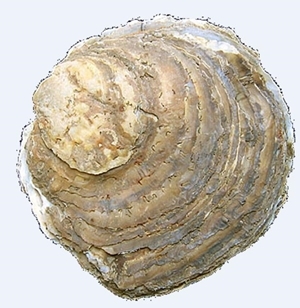The native oyster (Ostrea edulis)
 Native oysters may spawn from one year of age, but these small individuals don’t contribute much to the overall population. A 4cm oyster may produce around 100,000 eggs, while a 9cm oyster can produce close to 1.5 million and in some cases a single female oyster can produce up to a staggering 2 million eggs! So you can see that older oysters are important to the overall population and it is known that some can live up to 15 or even 20 years old and can attain sizes of up to 20cm.
Native oysters may spawn from one year of age, but these small individuals don’t contribute much to the overall population. A 4cm oyster may produce around 100,000 eggs, while a 9cm oyster can produce close to 1.5 million and in some cases a single female oyster can produce up to a staggering 2 million eggs! So you can see that older oysters are important to the overall population and it is known that some can live up to 15 or even 20 years old and can attain sizes of up to 20cm.
Native oysters can be found down to a depth of 80m on just about any type of seabed from bedrock to mud. They are also tolerant of wide range of wave and tidal conditions, and live in sheltered bays as well as exposed coasts. They can tolerate the reduced salinity that occurs when fresh and seawater mix, and so can be found in estuaries.
In the 1840s, more than 200 million oysters were sold annually on London markets, which considering the city’s population was under 2 million then, shows just how popular these shellfish were! In 1875, England alone had more than 15,000 boats and 50,000 people employed in the oyster business and they were not supplying just the wealthy. In fact it was stated at the time that “no other article of diet enters so generally into the consumption of every class”.
Such was the demand for oysters around this time that the inevitable happened – overfishing resulted in the collapse of many oyster beds. For a brief time, attention turned to the vast Scottish beds to supply hungry Londoners, bringing huge numbers down to the city by train.
The beds around the Firth of Forth extended to over 20 miles wide and were so plentifully stocked with oysters that three men in a boat could with ease collect 3,000 oysters in a couple of hours. That was however before larger dredging boats begun to clear vast areas completely, leaving them devoid of any breeding stock with which to replenish their numbers. The populations never recovered from this onslaught, and following a comprehensive survey in 1957, the oyster was declared extinct in the area.
The native oyster has declined to such an extent that it has been made a “UK biodiversity action plan priority species”. However, there is some hope in certain areas, such as the Blackwater oyster fishery in Essex, which has 12 registered boats and whose fishermen set self-imposed catch limits and gear restrictions. The fishermen have joined forces with the Essex wildlife trust who gather data from the beds, and so far this close monitoring of stocks has resulted in this area being the final stronghold for the native oyster on the east coast of England.
What I find most depressing about this near total collapse of such an abundant and important food source around 130 years ago, (important for many other species of wildlife who depended on them too) is that all this time later you only have to pick up a Sunday paper to read of the current over-exploitation of our seas. Why, oh why, are we so slow to learn from our past mistakes?
Peter Thompson
Advisory
Read more from Peter Thompson at the Fresh from the Field blog.

Download Peter Thompson's essential 26-page book, featuring beautiful photography and detailed profiles of Britain's wildlife
Download FREE >